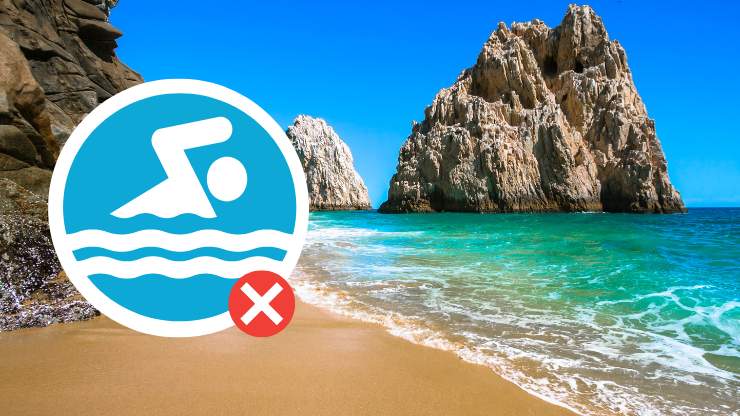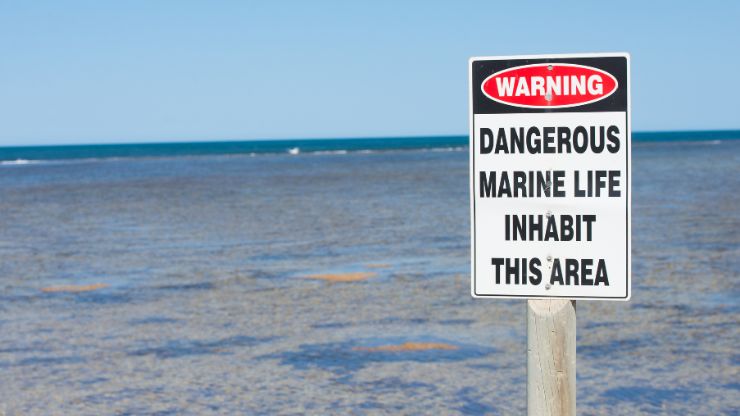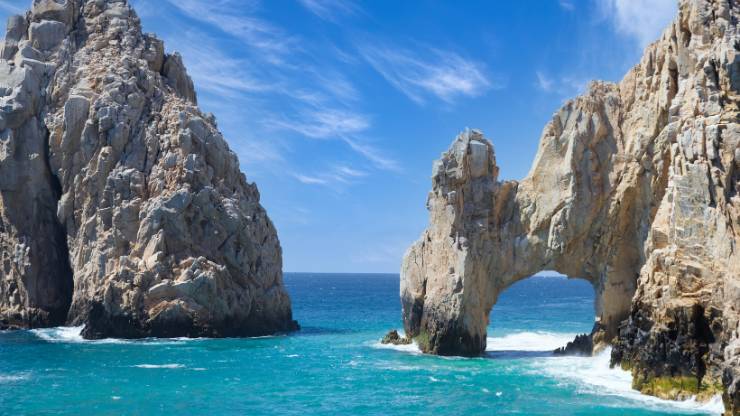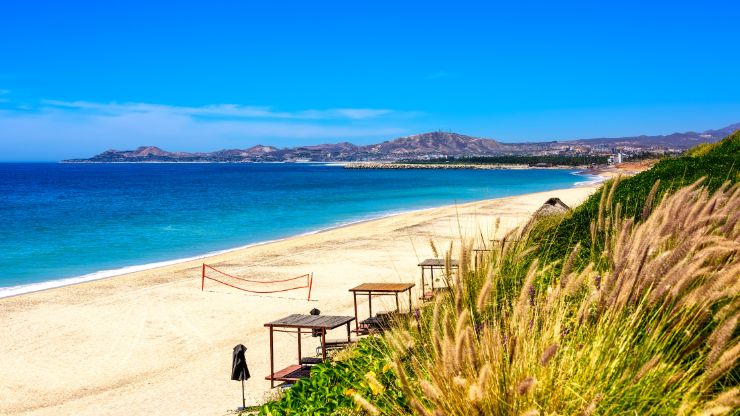The beaches in Cabo offer an experience that allows you to disconnect from everyday life and immerse yourself in the wonders and beauty of the ocean.
However, one thing to note is that not all beaches in Cabo are suitable for swimming. While some beaches offer an excellent opportunity for a refreshing swim, others may pose potential hazards that could endanger one’s life.
In this article, we’ll discuss the reasons why you cannot swim in Cabo, and reveal a few examples of swimmable and unswimmable beaches in Cabo. Plus safety tips to ensure a delightful beach vacation.
Is it true you can’t swim in Cabo?
The idea that you can’t swim in Cabo is not true. Cabo is a highly sought-after tourist destination in Mexico, renowned for its stunning beaches that offer both safety and enjoyment for swimming. However, it is crucial to consider local conditions, such as strong currents or rough waves, and follow any posted warnings or guidelines to ensure a safe swimming experience.

Why Are Some Cabo Beaches Not Swimmable?
Cabo San Lucas is home to some of the world’s most stunning beaches and crystal clear waters, but have you ever questioned why some of them are marked “not swimmable?”
There are several reasons why some Cabo beaches are not swimmable, which include the following:
- Rip currents
- Strong waves
- Undertows
- Steep cliffs
- Dangerous marine life
- No lifeguards
- Bad water quality
Let’s explain those reasons in a bit more detail.
Rip currents
The presence of rip currents is the number one reason to avoid swimming on certain beaches in Cabo. These powerful and fast-moving water currents, commonly known as “rip tides,” flow from the shore into the ocean.
Rip currents can be found on many beaches worldwide, not limited to just Los Cabos. However, it is important to note that Cabo is a highly sought-after tourist destination, and if you plan on visiting for leisure purposes, it is crucial to be mindful of this potential risk and avoid it.
Strong waves
Strong waves are another reason many beaches in the Los Cabos area are off-limits. Intense waves can provide a thrilling experience, but it is important to acknowledge that they can also pose a significant risk.
If you have visited Mexico before, Cabo is situated at the meeting point of the Pacific Ocean and the Gulf of California. This convergence of two oceans often results in the formation of powerful waves. These waves may appear enjoyable for surfers but overwhelming for swimmers or tourists like yourself.
When visiting Cabo, paying attention to local warnings and advice is crucial to enjoying the stunning beaches while ensuring your safety fully.
Undertows
Undertows are sneaky ocean currents that make swimming challenging at certain beaches in Cabo, Mexico. Let me explain the term “undertows” if you are unfamiliar with it.
Undertows occur when waves crash onto the shore and subsequently retreat into the ocean, but it’s important to note that they don’t always recede in the same direction.
On the contrary, these underwater currents possess significant force, capable of pulling you towards deeper waters. This occurrence can be quite intimidating, particularly for those who are unprepared.
Steep cliffs
You’ll find high sheer cliffs near vertical rock walls on several Cabo’s beaches. This Beach may not be as suitable for swimming due to the presence of these cliffs.
Try to picture yourself at the Beach, ready to take a refreshing dip, only to find that the approach to the water is a sheer cliff instead of a gentle slope.
Dangerous marine life
The beaches in Cabo are among the most stunning in the world. However, these beaches do not always allow swimming due to potentially dangerous marine life.
Some of Cabo’s beaches are home to potentially dangerous marine life, including jellyfish. These jellyfish-like creatures may look harmless, but their tentacles can inflict painful stings. In most cases, it won’t kill you, but it will make you miserable and end your beach day.
Another potential danger is running into some type of rays like stingrays or baby sharks every once in a while. Despite their generally docile nature, these creatures can still be disturbing and even dangerous if they feel threatened.

No lifeguards
Lifeguards are highly trained individuals who constantly monitor swimmers and beachgoers, These guys are always prepared to assist whenever someone requires help in the water.
However, it is important to note that not all beaches in Cabo have lifeguards, which makes them not totally safe for swimming especially for those who lack swimming skills.
Bad water quality
The problem of poor water quality on some beaches is another reason why you cannot swim in Cabo.
The water can be unclean due to various reasons, including sewage, street runoff, and natural factors like algae blooms. Therefore, swimming in such dirty water can cause illness which is the last thing you would want when traveling.
What Are The Non-Swimmable Beaches In Cabo?
Here are some examples of beaches in Cabo San Lucas that are generally considered unsafe for swimming:
- Playa Solmar
- Divorce Beach
- El Arco Beach
- Las Viudas Beach
- Twin Dolphin Beach
1. Playa Solmar
Playa Solmar, situated on the Pacific side of Land’s End, boasts breathtaking views and wide stretches of flawless white sand. Beach vendors are prohibited from entering the premises of this Beach.
Additionally, swimming is prohibited at this beach due to strong currents and powerful waves.
2. Divorce Beach
Divorce Beach offers a wonderful opportunity for sunbathing and relaxation. Despite its name, this Beach is surprisingly beautiful, boasting soft sand and captivatingly eroded rock formations.
However, it is important to note that swimming in the waters of Divorce Beach can be extremely dangerous due to strong currents, crashing waves, and rip tides.
Additionally, exercising caution while exploring this Beach is important due to the absence of lifeguards. If you are interested in swimming, you can easily reach Lovers Beach, known for its safer waters.
3. El Arco Beach
Cabo offers many fabulous attractions and activities that can transform any vacation into a truly memorable experience that will last a lifetime.
El Arco Beach is one of the most iconic attractions, known for its stunning rock formations and breathtaking beauty.
However, this Beach has been deemed unsafe for swimming by locals, tourists, and travelers due to its strong currents, rocky terrain, and limited facilities.

4. Las Viudas Beach
Widow’s Beach, also known as Playa Las Viudas, is a beautiful beach that offers a variety of attractions and activities for you to enjoy. These include sunbathing, bonfire parties, and much more.
However, like El Arco beach, Playa Las Viudas is unsuitable for swimming due to its powerful waves, which can pose a danger to swimmers. The Beach is known for its abundant rocks and underwater obstacles, making it potentially hazardous if proper caution is not exercised.
5. Twin Dolphin Beach
Twin Dolphin Beach, also known as Playa Twin Dolphin, is a popular destination for tourists searching for scenic beaches and breathtaking coastal vistas. Please exercise caution if you insist on swimming there, though.
The first reason why you can’t swim on this beach in Cabo is the water’s inherent dangers, such as strong currents and constantly shifting tides.
If you can’t swim, don’t venture into deeper water because of these currents. Secondly, the lack of lifeguard stations means little supervision or assistance is available on the Beach.
What Are The Swimmable Beaches In Cabo?
Although I previously mentioned that certain beaches in Cabo are unsuitable for swimming, some beaches are perfect for a wide range of activities, including swimming.
Some examples of swimmable beaches in Cabo, Mexico Include:
- Monuments Beach
- Medano Beach
- Palmilla Beach
- El Chileno Beach
- Lovers Beach
1. Monuments Beach (Playa Monumentos)
Playa Monumentos in Cabo San Lucas, Mexico, is one of the fantastic swimmable beaches in Cabo that offers travelers the perfect opportunity to bask in the sun and have a great time.
Numerous activities are available for you to enjoy, including swimming, snorkeling, surfing, kayaking, sailing, or simply relaxing on the beautiful white sand while observing the waves crashing onto the shore.
Additionally, if you are seeking more adventure, you can venture beyond the shore. There, you will discover a plethora of marine life, making it an excellent location for scuba diving.
Additionally, Playa Monumentos provides access to various excellent restaurants where you can indulge in delectable Mexican cuisine or unwind with a refreshing margarita while enjoying the breathtaking sunset over Cabo San Lucas Bay.
2. El Medano Beach
Medano Beach is widely renowned for its peaceful and crystal-clear waters, making it one of the most desirable beaches for swimming in Cabo. Whether you are a family seeking a safe and enjoyable beach experience or simply looking to unwind by the water, El Medano Beach is the perfect choice.
The Beach is known for its vibrant environment, where numerous restaurants and bars serve refreshing drinks and delicious food. In addition to swimming, you can enjoy several other water sports and activities, including jet-skiing, paddle-boarding, and kayaking.
Read my previous travel guide to Medano Beach in Cabo to learn more about this beautiful beach and how you can spend an amazing journey there.

3. Palmilla Beach
Playa Palmilla is a breathtaking beach that boasts crystal-clear turquoise waters and an enormous stretch of soft sandy shoreline. Swimming and snorkeling are prevalent activities on this Beach, thanks to the tranquil waters that offer a safe and delightful experience.
Additionally, you can relax on the sand, go for a refreshing swim, or embark on an adventure to discover the abundant marine life in the vicinity. The Beach is also a popular destination for engaging in water sports such as jet-skiing, paddle-boarding, and kayaking.
Further reading: Travel Guide To Palmilla Beach in Cabo
4. El Chileno Beach
Chileno Beach, situated midway between Cabo San Lucas and San Jose del Cabo, is renowned as one of the top snorkeling destinations in Los Cabos.
If you are fortunate, you can observe lobsters, sea urchins, stingrays, and various vibrant fish. This serene Beach offers palapas, portable restrooms, and a conveniently located restaurant.
Additionally, it boasts a serene bay that is perfect for swimming.
Further reading: Travel Guide To Chileno Beach in Cabo
5. Lovers Beach (Playa del Amor)
Like many other beaches in central Cabo, Lovers Beach has calm, clear water that is great for swimming and snorkeling. However, there are times when the waves are too high, so it’s best to play it safe.
It could be a romantic spot if you find yourself alone here, but you should plan accordingly and bring your supplies.
For more options, visit my previous article about the best swimmable beaches in Los Cabos.
Further reading: Travel Guide To Lovers Beach in Cabo
The Flag System On Cabo’s Beaches
There are flags on some of Cabo’s beaches that show you the current condition of the water and whether or not it is safe to swim which is a good thing added by the Mexican government.
The beach flags’ colors in Mexico mean the following things:
- Red flag: Don’t swim here because it’s dangerous.
- Yellow flag: Medium risk is represented by a yellow flag. Take precautions if you choose to swim here.
- Green flag: This indicates that the Beach is suitable for swimming.
- White flag: It means you should exercise caution when entering the water due to the presence of potentially dangerous marine life, such as jellyfish and sharks.
- A black flag: It means you can’t even go to the Beach, let alone get in the water. This is usually because of heavy rain, storms, or hurricanes.
How To Swim Safely In Los Cabos?
To safely enjoy your time at the beaches in Cabo without compromising your health, I would like to share some simple things you should know.
Do plenty of research
In addition to the general risks, every Beach has its risks. For example, the weather at Playa Solmar is known to change quickly from sunny to stormy in minutes. Or, El Arco Beach might have rip currents. Therefore, it’s best to learn as much as possible about the Beach you want to go to.
Making plans like these is necessary to ensure that something bad doesn’t happen on a fun day.
Swim in designated areas
You might feel drawn to seek relief in the water on a scorching summer day. However, whether you choose to swim laps or take a brief plunge, it is crucial to do so in a designated area.
Swimming in these designated areas enables lifeguards to closely monitor the water and swiftly assist you if any difficulties arise.
Check the weather forecast
The weather in Cabo varies greatly depending on the month. One moment, you may enjoy sunny and clear skies, but the next, you may find a tropical storm approaching the horizon.
So, before embarking on any vacation, it is always essential to prioritize checking the weather forecast.
Don’t swim alone
It is never a good idea to swim alone, regardless of your age or swimming skills. It is always important to have a buddy or someone else accompany you.
Wear a life jacket
You may have confidence in your swimming skills and even be an Olympic swimmer! However, it is important to acknowledge that life jackets hold significance for individuals of all backgrounds, including professionals.
Losing a sense of direction can be quite common at the Beach, particularly if you fall out of a raft or lose control while swimming. Life jackets are designed to help you float in the water and ensure your head remains above the surface.
Final Thoughts
Although Cabo offers a wide range of attractions and activities, it is important to note that swimming is generally not recommended on certain beaches due to various factors such as strong undertow, powerful waves, the presence of marine life, and potential water pollution.
Prioritizing safety and adhering to advisories or warnings issued by local authorities is always essential.
